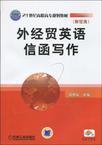外经贸英语信函写作
出版时间:2010-1 出版社:机械工业出版社 作者:吴思乐 编 页数:183
前言
《外经贸英语信函写作》是机械工业出版社21世纪高职高专(财经类)规划教材之一,是涉外经贸类专业的专业技能课程用书。本书遵循目前高职教学中“基于工作过程的模块式教学”要求,更多地体现“简单”、“实用”的特色,力求切合高职商务英语、国际商务等涉外经贸专业课程的教学实际。本教材通过大量的技能训练,把基础英语技能和外贸英语知识有机地结合起来,使学生通过学习,具备撰写国际商务英语函电的能力,因而具有较强的专业性和实用性。 全书根据外贸业务的主要流程和内容划分为6个模块,每个模块开头都有一个教学目的和教学重难点部分,让学生了解在本单元商务环节中往来函电的基本要求和重难点。 除第一个信函写作基本知识模块以外,其他各模块均由以下几部分内容组成: 第一部分:Writing Skills(信函写作技巧) 本部分通过文字介绍、信例等形式将各个贸易环节中函电的内容、形式、写作步骤和技巧等清晰直观地描述出来,让学生可以对本单元内容的核心部分有个完整的了解。这一部分是函电撰写知识的核心,充分体现了典型性和实用性。 第二部分:Useful Plnrases an(1 Expressions(常用短语和表达) 第三部分:Typical Sentences(典型例句) 第二、三部分主要是介绍和总结那些在各模块环节中出现的最常用的、最经典的短语、表达和句型,用以向学生提供一些可供背诵、熟记的素材,从而加深学生对前一部分内容的感性认识,实现知识点的巩固和消化,为下一步的知识运用做好准备。这一部分有总结、复习的作用,有较大的归纳性。
内容概要
本书是21世纪高职高专规划教材。本书以商品进出口贸易程序为主线,主要介绍进出口双方在合同的洽谈和履行过程中进行的往来函电交流用语和相关知识。主要内容有信函写作基本知识、业务磋商的准备、业务磋商的主要环节、交易的达成、主要交易条款的磋商、合同履行过程中的争议及争议的解决等6个模块,具体包括了询盘、报盘、还盘、接受与确认、订单、寄送合同、支付、信用证、包装、运输、保险、申诉、索赔、理赔等进出口贸易各个环节。本书内容全面,介绍内容深入浅出,侧重应用性和实践性,既可作为高职高专对外经贸领域各专业学生的教材,也可供从事外经贸工作的人员阅读和使用。
书籍目录
前言Module one Basic Knowledge of Business Letter Writing(信函写作基本知识) Section 1 Basic Requirements of Business Letter Writing(信函写作基本要求) Section 2 Basic Parts/Contents and Ways of Writing(基本内容和写法) Section 3 Layout and Style of Business Letters(书信格式) Section 4 Envelope Addressing(信封书写) Section 5 Training and Practice(操练与实践) Module Two Preparations for Negotiation(业务磋商的准备) Section 1 Request for Establishment of Business Relations(要求建立业务关系) 1.1 Writing Skills 1.2 Useful Phrases and Expressions 1.3 Typical Sentences 1.4 Training and Practice Section 2 Credit Inquiry and Marketing Research(资信调查和市场调查) 2.1 Writing Skills 2.2 Useful Phrases and Expressions 2.3 Typical Sentences 2.4 Training and PracticeModule Three Procedures of Business Negotiation(业务磋商的主要环节) Section I Inquiry(询盘) 1.1 Writing Skills 1.2 Useful Phrases and Expressions 1.3 Typical Sentences 1 4 Training and Practice Section 2 Offer(报盘) 2.1 Writing Skills 2.2 Useful Phrases and Expressions 2.3 Typical Sentences 2.4 Training and Practice Section 3 Counter—offer(还盘) 3.1 Writing Skills 3.2 Useful Phrases and Expressions 3.3 Typical Sentences 3.4 Training and Practice Section 4 Acceptance and Confirmation(接受与确认) 4.1 Writing Skills 4.2 Useful Phrases and Expressions 4.3 Typical Sentences 4.4 Training and PracticeModule Four Conclusion of Business(交易的达成) Section l Order(订单) 1.1 Writing Skills 1.2 Useful Phrases and Expressions 1.3 Typical Sentences 1.4 Training and Practice Section 2 Contract Sending(寄送合同) 2.1 Writing Skills 2.2 Useful Phrases and Expressions 2.3 Typical Sentences 2.4 Training and PracticeModule Five Negotiation of Trade Terms(交易条款的磋商) Section l Payment(支付) 1.1 Writing Skills 1.2 Useful Phrases and Expressions 1.3 Typical Sentences 1.4 Training and Practice Section 2 Letter of Credit(信用证) 2.1 Writing Skills 2.2 Useful Phrases and Expressions 2.3 Typical Sentences 2.4 Training and Practice Section 3 Packing(包装) 3.1 Writing Skills 3.2 Useful Phrases and Expressions 3.3 Typical Sentences 3.4 Training and Practice Section 4 Shipment(运输) 4.1 Writing Skills ……Module Six Disputes and Settlement During the Execution of Contracts(合同履行过程中的争议及争议的解决)参考文献
章节摘录
1. Completeness (完整) Business letters should avoid incompleteness. A business communication should include all the necessary information. It is essential to check the message carefully before it is sent out to see that all the matters are discussed, and all the questions are answered. 2. Concreteness(具体) Concreteness means making the message specific, definite and vivid. Business letters should avoid being too general. In general letters, everything seems to be mentioned but actually few are fully expounded. You should use specific facts and figures, vivid and image-building words. 3. Clearness/Clarity (清楚) Make sure that your letter is so clear that it cannot be misunderstood. A point that is ambiguous in a letter will cause trouble to both sides, and further exchange of letters for explanation will become inevitable, thus time will be lost. The writers must try to express themselves clearly. To achieve this, they should keep in mind the purpose of their letter and use appropriate words in correct sentence structure to fully convey their meaning. When you are sure about what you want to say, say it in plain and simple words. Short, familiar, conversational and straight-forward English is what is needed for business letters. 4. Conciseness (简洁,简明) Conciseness is often considered to be the most important writing principle. It means saying things in the fewest possible words. To achieve this, try to avoid wordiness or redundancy. Clearness and conciseness often go hand-in-hand, and the elimination of wordy business jargon can help to make a letter clearer and more concise at the same time. A concise letter is not necessarily a short one. Sometimes, perhaps a letter dealing with a multiplicity of matters cannot avoid being long. Generally speaking, you will gain in clearness and conciseness by writing short sentences rather than long ones.A letter can be made clearer and easier to read and more attractive to look at by writing short sentences and careful paragraphing. One paragraph for one point is a good rule.
图书封面
评论、评分、阅读与下载
用户评论 (总计0条)
相关图书
- 网络与信息安全技术
- 中文版Flash CS4入门与进阶
- 鳄鱼街
- H高中作文读本第6册
- 秘藏1937
- 从头到脚说健康2
- 四川大学学报(工程科学版)
- 金属体积成形工艺及数值模拟技术
- 园林景观植物树木图典
- 家庭装饰三步曲
- 奥比岛
- 奥比岛
- 奥比岛
- 会得美人无限意.红楼梦女性角色智慧品读
- F高中语文3下/天府名校四七九模拟精编
- F高中数学3下(文理合卷)/天府名校四七九模拟精编
- F高中英语3下/天府名校四七九模拟精编
- F高中文科综合/天府名校四七九模拟精编
- F高中理科综合/天府名校四七九模拟精编
- H语文9年级/名校联盟中考探究与测试
- F英语9全(配外研)/名校联盟中考探究与测试
- F数学(配北师大)/名校联盟中考探究与测试
- F物理(配沪科版)/名校联盟中考探究与测试
- F化学9全(配人教)/名校联盟中考探究与测试(广安地区)
- F政治9全(配教科)/名校联盟中考探究与测试
